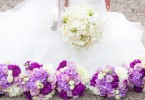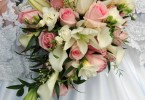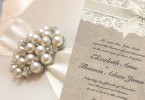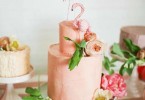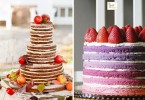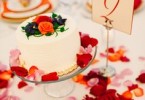In addition to having her own bouquet, a bride may plan on several other floral accessories, both for herself and for certain members of the wedding party. The outfits for the groomsmen, ushers, bridesmaids, flower girls, ring-bearers, and, of course, the immediate family all go toward creating the total look for her wedding day. Their clothes need to harmonize with the bride’s dress and complement the overall theme of the wedding, and this is equally true of any floral accessories they wear. They should enhance but not outshine the bride.
Here are seven things that can accompany a bride:
Step 1 – Adding Flowers in the Hair
Flowers worn by the bride in her hair on her wedding day can be one of the most exquisite accessories. Wearing a ring of flowers is a tradition that dates from Ancient Greece. This is the most popular floral accessory, and it should be planned in conjunction with your bouquet and will involve collaboration between your hairdresser and your florist. Your choice of headdress will also be influenced by how you decide to wear your hair and whether or not you are going to wear a veil.
Bride’s can choose to wear a single large flower, a number of small wired florets (individual rosebuds or stephanotis, for example), a full headband, a floral circlet or a tiara, which is usually made from very delicate florets (such as hyacinths, stephanotis, or tuberose). A headband or comb of flowers is most often worn in front of the veil and this is the clever technique for adding a little more to your height if you need to.
Fresh flowers near your face can make you look younger, your skin rosier, and your eyes brighter. It is, after all, probably the only time you are going to be able to wear flowers in your hair, and there is something wonderfully indulgent about bedecking yourself with fresh flowers. However, if you are planning a headdress it is important that you have a run through with your hairdresser and it is certainly worthwhile asking your florist to make a trial headdress for you, as you do not want any snags or surprises on the day!
Some brides may choose to wear a hat, and this can also be decorated with fresh flowers and foliage. Ideally, flowers should be placed on a wider brimmed hat and deliver the two together on your wedding day. Sometimes the mother of the bride or groom may choose this accessory instead of wearing a corsage. Matrons-of-honor may also prefer this, and some of your guests will like the idea, too.
Step 2 – Adding Florals in Necklaces and Bracelets
It is customary in India to wear floral garlands around the neck or wrist and is often made in weddings with mixed cultures. At a Hindu wedding, the bride and groom exchange sumptuous garlands, mainly of red and white flowers decorated with silver, assembled by threading the flower head into wire. Carnations work well for these, as they are relatively inexpensive (a factor when so many flower heads are needed) and are durable.
Some brides like to break with convention and wear something more unusual, such as a floral boa or a necklace of flowers. If you choose a necklace, you need to have a good elegant neck, so experiment first! Wrist corsages can also add glamour to a bridal dress and look fabulous on more mature bridesmaids or matrons-of honor. Some brides choose to have their shoes adorned with fresh cut flowers which peep out from under the gown when they walk. If you are planning something out of the ordinary, it is worth spending a little bit more money and asking your florist to make you a prototype to try out. That way you can be sure you are happy with your ideas. If you wish to sew flower heads onto your dress, you will have to ask your florist to wire them, so that the stem is removed, making it easier for you to attach them to your gown. A few miniature rose heads sewn to the veil can look very romantic.
Step 3 – Adding Floral Accessories for the Young
Younger bridesmaids, flower girls, and young ring-bearers are often dressed more seasonally than the bride, with more attention to the time of year. In winter, bridesmaids may wear fake muffs decorated with flowers. How you decide to dress your attendants will depend largely on their ages, the time of the year, and any theme you are planning for the wedding. Your contemporaries are not going to speak to you again if you dress them in a sugar-almond pink tutu and give them a set of iridescent wings and a floral wand, but your three year old niece will undoubtedly think it the highlight of the year! Floral headdresses are best for the younger bridesmaids, and there are two types that are suitable for young children with especially fine hair€”a circlet that goes all around the head and sits on the crown or a headband, where the flowers are wired onto a frame. It is a good idea to give your florist a size for the circlet as a guide. This measurement will depend on the bridesmaid going to wear it; however they are usually framed with a hook, which can be adjusted on the day.
Sometimes a headband can be the most practical option since you can ask your bridesmaid to break one in before having your florist attach the flowers and deliver it on the day. You may even ask your dressmaker to cover a band with fabric to match the bridesmaid’s dresses. Some bridesmaids are more stoical than others about wearing headdresses, and it is worth spending a little time thinking about this to avoid having a floral headdress cause a high drama just before your big moment. If you are lucky enough to have a hairdresser with you while you are dressing ask them to fit the floral headdresses for your attendants.
Step 4 – Adding Baskets of Flowers
Baskets filled with fresh cut flowers are a very popular bridesmaid’s accessory. One of the main advantages of a basket is that it allows the bridesmaid to put down her flowers when necessary, whereas a bouquet if constantly handled can become damaged around the edges and start to droop. Baskets of petals are also very popular, and attendants can sprinkle petals on the floor before the entrance of the bride to create a gorgeous scent. Alternatively, rose petals can be put into pretty paper cones and handed to all the guests to scatter at the end of the ceremony.
Step 5 – Adding Flowers to Your Attendants
When choosing flowers for your attendants to carry, remember that they should complement your overall scheme and be appropriate to your attendants’ outfits and size, as you do not want to overburden them. An experienced florist will advise you on this. Most often bridesmaids carry smaller bouquets, as this is the least expensive option. The flowers are usually more colorful than the bridal bouquet and are made in proportion to the size of the person carrying them, so be sure to let your designer know their ages. Make sure that your chief bridesmaid shows the smaller attendants how to hold their flowers, and to keep their arms relaxed so that they look their best as they walk into the ceremony.
Step 6 – Adding Floral Boutonnieres
As well as other wedding flowers it is customary to order special boutonnieres for your fianc©, his father, and grandfather and your father, the best man, and all the ushers. The boutonnieres usually chosen to suite men’s ties and other flowers, so white are often the safest and easiest option, though you might pick a special color for your own father and fianc©. Although it is a lovely idea to want to give all your guests a floral accessory such as a boutonniere it is quite expensive and can be needlessly extravagant. In my experience, very often people do not want to pin a flower onto their outfit, so these gifts are passed by. If you are going to make this gesture, make sure you appoint an usher to offer them to each guest as they arrive at the ceremony, and make sure your florist has labeled any special flowers so that they can be offered to the appropriate person.
Step 7 – Adding Floral Decorated Bags
It is traditional for mothers and grandmothers of the happy couple

